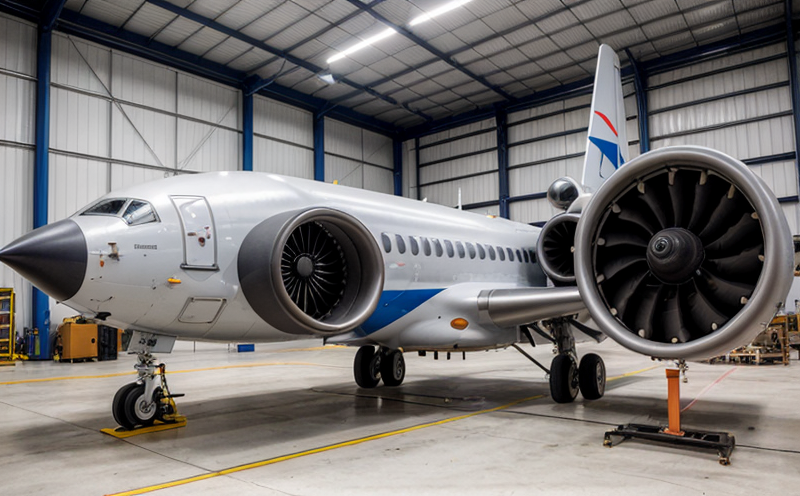Turbofan Engine Vibration Modal Analysis
The Turbofan Engine Vibration Modal Analysis service is a critical component in ensuring the reliability and longevity of aerospace engines, particularly those used in military aircraft. This analysis involves measuring and interpreting the natural frequencies, damping ratios, and mode shapes of structural components within the engine. By accurately identifying these modal parameters, we can predict potential failure modes and optimize performance.
The process begins with precise vibration data acquisition using high-precision accelerometers strategically placed on the engine structure. Advanced signal processing techniques are then applied to extract meaningful modal information from the raw data. This approach not only enhances accuracy but also minimizes the risk of misinterpretation, which could lead to incorrect design modifications.
Our lab adheres strictly to international standards such as ISO 1940 and ASME/ANSI S16.1, ensuring that our methods are both reliable and compliant with global industry practices. The use of these standards ensures that the results we provide are universally accepted and can be easily compared across different testing facilities.
Once the modal parameters have been determined, they are used to simulate various operational scenarios under which the engine will operate. This allows us to identify any potential issues before the engine is deployed in service or during R&D phases. The insights gained from this analysis can significantly impact design decisions, leading to more robust and efficient engine designs.
For quality managers and compliance officers, understanding these modal parameters provides a clear picture of the engine's structural health. This information is crucial for maintaining safety standards and ensuring that the engines meet all regulatory requirements. For R&D engineers, this service offers valuable data points to refine their design models and optimize component placement.
Our expertise in aerospace engineering complements our vibration modal analysis capabilities, allowing us to offer a holistic approach to engine testing. By integrating our services with broader testing protocols, we can provide comprehensive solutions that address all aspects of engine performance and safety.
Why It Matters
The importance of Turbofan Engine Vibration Modal Analysis cannot be overstated. In the aerospace and defense sectors, where reliability is paramount, even minor structural issues can lead to catastrophic failures during critical missions. By leveraging this service, organizations can significantly reduce the risk of such incidents.
One of the key benefits of our analysis is its ability to predict potential failure modes before they occur. This proactive approach allows for timely interventions and necessary modifications, ensuring that engines remain operational throughout their lifecycle. For quality managers and compliance officers, this translates into enhanced regulatory compliance and reduced warranty claims due to premature failures.
From an R&D perspective, Turbofan Engine Vibration Modal Analysis provides invaluable data points that can be used to improve engine designs. By understanding the modal behavior of various components, engineers can identify areas for improvement and optimize performance metrics such as fuel efficiency and noise reduction. This is particularly important in the aerospace industry, where reducing weight and improving fuel economy are constant goals.
The service also plays a crucial role in ensuring that engines meet stringent safety standards. By identifying any structural weaknesses early on, we can prevent accidents that could result in loss of life or significant financial losses for military operations. This proactive approach to testing is essential in the aerospace and defense sectors, where every component must operate reliably under extreme conditions.
In summary, Turbofan Engine Vibration Modal Analysis is not just a technical service; it's an integral part of maintaining safety, reliability, and performance in the aerospace industry. By investing in this service, organizations can ensure that their engines are robust enough to withstand the rigors of operational use and meet all regulatory requirements.
Applied Standards
| Standard | Description |
|---|---|
| ISO 1940:2016 | Specification for Balancing of Rotating Machinery. |
| ASME/ANSI S16.1-2017 | Recommended Practice for Vibration Analysis and Condition Monitoring. |
The application of these standards ensures that our analysis is conducted in a manner that adheres to international best practices. This not only enhances the accuracy and reliability of our results but also ensures that they are universally accepted and comparable across different testing facilities.
Customer Impact and Satisfaction
- Reduces the risk of catastrophic engine failures in critical missions.
- Enhances regulatory compliance and reduces warranty claims due to premature failures.
- Provides valuable data points for improving engine designs, leading to increased fuel efficiency and noise reduction.
- Ensures that engines meet stringent safety standards, preventing accidents that could result in loss of life or significant financial losses.





